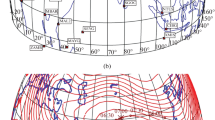Abstract
The total electron content (TEC) data during the total eclipse of March 9, 1997 were collected, which were observed by means of nine GPS receivers located at the eastern Asia. The responses of total TEC to the eclipse were analyzed. The results show that: 1) the eclipse led to apparent decrement in TEC that lasted for six to eight hours; 2) the maximum decrement occurred after the middle of the eclipse with time-delays varying from twenty minutes to about three hours; 3) the maximum absolute deviations of TEC on the eclipse day do not show a simple and consistent relationship to the maximum solar obscuration.
Similar content being viewed by others
References
Olatunji E O. An eclipse in the equatorialF-region [J].J Atmos Terr Phys, 1967,29: 267–275.
Fritz R B. Response of ionosphere and exosphere electron contents to a partial solar eclipse[J].J Geophys Res, 1968,73: 4994–4998.
Klobuchar J A. Ionospheric total electron content measurements in solar eclipse[J].Natl Sci Found, 1973,Bull5: 80–84.
LI Jun. Observation of the ionospheric total electron content during the solar eclipse of February 16, 1980 [J].Chinese J of Geophys, 1981,24: 252–256(Ch).
Yeh K C. Ionospheric response to a solar eclipse in the equatorial anomaly region[J].Terrestrial, Atomosphere and Oceanic Sciences, 1997,8: 165–178.
Xu J S. Observations of the ionospheric total electron contents during the solar eclipse of october 24, 1995 by Using the GPS Beacon[J].Terrestrial, Atomosphere and Oceanic Sciences, 1997,8: 179–188.
CHEN Pei-ren, The ionospheric response to the atmospheric quasi-biennial oscillation[J].Chinese J of Geophys, 1992,35: 294–303 (Ch).
Sardon E A. Estimation of total electron content using GPS data: How stable are the differential satellite and receiver instrumental biases[J].Radio Sci, 1997,29: 577–586.
Evans J V. AnF-region eclipse[J].J Geophys Res, 1965,70: 131–142.
Author information
Authors and Affiliations
Additional information
Foundation item: Supported by the National Natural Science Foundation of China(49684002)
Biography: CHEN An-hua (1976-), female, Master candidate. Research interests: studying ionosphere by GPS beacons.
Rights and permissions
About this article
Cite this article
An-hua, C., Sheng-bing, Y. & Ji-sheng, X. Ionospheric responses to a total solar eclipse deduced by the GPS beacon observations. Wuhan Univ. J. Nat. Sci. 4, 439–444 (1999). https://doi.org/10.1007/BF02832278
Received:
Issue Date:
DOI: https://doi.org/10.1007/BF02832278




